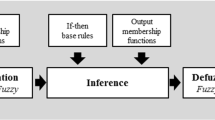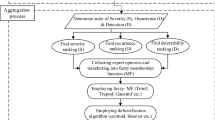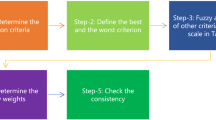Abstract
Reliability and safety in the process industries like automotive industry are important key success factors for upgrading availability and preventing catastrophic failures. In this context, failure mode and effect analysis (FMEA) technique is a proactive diagnostic tool for evaluating all failure modes which reduces the highest risk priority failures. However, it still suffers from subjective uncertainty and ambiguity which are important factors in risk analysis procedures. Hence, this paper provides a comprehensive survey to overcome the drawbacks of the traditional FMEA through improved FMEA, incorporating the fuzzy inference system (FIS) environment. For this purpose, the effective attributes, such as; various scales and rules, various membership functions, different defuzzification algorithms and their impacts on fuzzy RPN (FRPN) have been investigated. Moreover, three types of sensitivity analysis were performed to identify the effect and authority control of risk parameters, i.e., severity, occurrence and detection on FRPN. To demonstrate the feasibility of the proposed framework, as a practical example, the method was implemented in complex equipment in an automotive production line. The result of FIS-FMEA model revealed that the proposed framework could be useful in recognizing the failure modes with critical risk values compared to the traditional FMEA. Given the potential applications of this approach, suitable maintenance actions can be recommended to improve the reliability and safety of process industry, such as automotive production line.














Similar content being viewed by others
References
Carbone TA, Tippett DD (2004) Project risk management using the project risk FMEA. Eng Manag J 16(4):28–35
Bahill AT, Smith ED (2009) An industry standard risk analysis technique. Eng Manag J 21(4):16–29
Chemweno P, Pintelon L, Muchiri PN, Van Horenbeek A (2018) Risk assessment methodologies in maintenance decision making: a review of dependability modelling approaches. Reliab Eng Syst Saf 173:64–77
Jiang Y, Yin S (2018) Recent advances in key-performance-indicator oriented prognosis and diagnosis with a matlab toolbox: Db-kit. IEEE Trans Ind Inf 15(5):2849–2858
Soltanali H, Garmabaki AHS, Thaduri A, Parida A, Kumar U, Rohani A (2019) Sustainable production process: an application of reliability, availability, and maintainability methodologies in automotive manufacturing. Proc Inst Mech Eng Part O J Risk Reliab 233(4):682–697
Jiang Y, Yin S, Kaynak OJIA (2018) data-driven monitoring and safety control of industrial cyber-physical systems: basics and beyond. IEEE Access 6:47374–47384
Jiang Y, Yin S (2017) Recursive total principle component regression based fault detection and its application to vehicular cyber-physical systems. IEEE Trans Ind Inf 14(4):1415–1423
Duffuaa SO, Raouf A (2015) Reliability-centered maintenance, in planning and control of maintenance systems. Springer, Berlin, pp 245–260
Liu HC, Liu L, Liu N (2013) Risk evaluation approaches in failure mode and effects analysis: a literature review. Expert Syst Appl 40(2):828–838
Kumru M, Kumru PY (2013) Fuzzy FMEA application to improve purchasing process in a public hospital. Appl Soft Comput 13(1):721–733
Keskin GA, Özkan C (2009) An alternative evaluation of FMEA: fuzzy ART algorithm. Qual Reliab Eng Int 25(6):647–661
Sharma RK, Sharma P (2015) Qualitative and quantitative approaches to analyse reliability of a mechatronic system: a case. J Ind Eng Int 11(2):253–268
Hsu HM, Chen CT (1996) Aggregation of fuzzy opinions under group decision making. Fuzzy Sets Syst 79(3):279–285
Woodhouse S (2003) Engineering for safety: use of failure mode and effects analysis in the laboratory: a well-known engineering tool now being used to assure patient safety. Lab Med 36(1):16–18
Silva MM, De Gusmão APH, Poleto T, Silva LC, Costa APCS (2014) A multidimensional approach to information security risk management using FMEA and fuzzy theory. Int J Inf Manag 34(6):733–740
Wang YM, Chin KS, Poon GKK, Yang JB (2009) Risk evaluation in failure mode and effects analysis using fuzzy weighted geometric mean. Expert Syst Appl 36(2):1195–1207
Feili HR, Akar N, Lotfizadeh H, Bairampour M, Nasiri S (2013) Risk analysis of geothermal power plants using failure modes and effects analysis (FMEA) technique. Energy Convers Manag 72:69–76
Cagliano AC, Grimaldi S, Rafele C (2011) A systemic methodology for risk management in healthcare sector. Saf Sci 49(5):695–708
Hekmatpanah M, Shahin A, Ravichandran N (2011) The application of FMEA in the oil industry in Iran: the case of four litre oil canning process of Sepahan Oil Company. Afr J Bus Manag 5(7):3019
Kang HG, Kim MC, Lee SJ, Lee HJ, Eom HS, Choi JG, Jang SC (2009) An overview of risk quantification issues for digitalized nuclear power plants using a static fault tree. Nucl Eng Technol 41(6):849–858
Bertolini M, Bevilacqua M, Massini R (2006) FMECA approach to product traceability in the food industry. Food Control 17(2):137–145
Pollard SJ, Strutt JE, MacGillivray BH, Hamilton PD, Hrudey SE (2004) Risk analysis and management in the water utility sector: a review of drivers, tools and techniques. Process Saf Environ Prot 82(6):453–462
Press D (2003) Guidelines for failure mode and effects analysis (FMEA), for automotive, aerospace, and general manufacturing industries, Chapter 12. CRC Press, Boca Raton, pp 67–72
Liu HC, Li P, You JX, Chen YZ (2015) A novel approach for FMEA: combination of interval 2-tuple linguistic variables and gray relational analysis. Qual Reliab Eng Int 31(5):761–772
Chanamool N, Naenna T (2016) Fuzzy FMEA application to improve decision-making process in an emergency department. Appl Soft Comput 43:441–453
Kirkire MS, Rane SB, Jadhav JR (2015) Risk management in medical product development process using traditional FMEA and fuzzy linguistic approach: a case study. J Ind Eng Int 11(4):595–611
Li Y, Wang X (2018) Risk assessment for public–private partnership projects: using a fuzzy analytic hierarchical process method and expert opinion in China. J Risk Res 21(8):952–973
Yazdi M, Daneshvar S, Setareh H (2017) An extension to fuzzy developed failure mode and effects analysis (FDFMEA) application for aircraft landing system. Saf Sci 98:113–123
Zhou Q, Thai VV (2016) Fuzzy and grey theories in failure mode and effect analysis for tanker equipment failure prediction. Saf Sci 83:74–79
Liu HC, Chen YZ, You JX, Li H (2016) Risk evaluation in failure mode and effects analysis using fuzzy digraph and matrix approach. J Intell Manuf 27(4):805–816
Helvacioglu S, Ozen E (2014) Fuzzy based failure modes and effect analysis for yacht system design. Ocean Eng 79:131–141
Kuo RJ, Wu YH, Hsu TS (2012) Integration of fuzzy set theory and TOPSIS into HFMEA to improve outpatient service for elderly patients in Taiwan. J Chin Med Assoc 75(7):341–348
Feng M (2008) FMEA method based upon fuzzy set theory and grey relational theory. Ind Eng J 11(4):109–112
Hadi-Vencheh A, Hejazi S, Eslaminasab Z (2013) A fuzzy linear programming model for risk evaluation in failure mode and effects analysis. Neural Comput Appl 22(6):1105–1113
Camastra F, Ciaramella A, Giovannelli V, Lener M, Rastelli V, Staiano A, Staiano G, Starace A (2015) A fuzzy decision system for genetically modified plant environmental risk assessment using Mamdani inference. Expert Syst Appl 42(3):1710–1716
Geramian A, Abraham A, Ahmadi Nozari M (2018) Fuzzy logic-based FMEA robust design: a quantitative approach for robustness against groupthink in group/team decision-making. Int J Prod Res 57(5):1–14
Chiozza ML, Ponzetti C (2009) Failure mode and effect analysis (FMEA): a model for reducing medical errors. Clin Chim Acta 404(1):75–78
Dağsuyu C, Göçmen E, Narlı M, Kokangül A (2016) Classical and fuzzy FMEA risk analysis in a sterilization unit. Comput Ind Eng 101:286–294
Renjith V, Kumar PH, Madhavan D (2018) Fuzzy FMECA (failure mode effect and criticality analysis) of LNG storage facility. J Loss Prev Process Ind 56:537–547
Filo G, Fabiś-Domagała J, Domagała M, Lisowski E, Momeni H (2018) The idea of fuzzy logic usage in a sheet-based FMEA analysis of mechanical systems. In: MATEC web of conferences. EDP Sciences, vol 183, p 03009
Tay KM, Lim CP (2010) Enhancing the failure mode and effect analysis methodology with fuzzy inference techniques. J Intell Fuzzy Syst 21(1–2):135–146
Liu HC, You JX, Lin QL, Li H (2015) Risk assessment in system FMEA combining fuzzy weighted average with fuzzy decision-making trial and evaluation laboratory. Int J Comput Integr Manuf 28(7):701–714
Gargama H, Chaturvedi SK (2011) Criticality assessment models for failure mode effects and criticality analysis using fuzzy logic. IEEE Trans Reliab 60(1):102–110
Liu HT, Tsai YL (2012) A fuzzy risk assessment approach for occupational hazards in the construction industry. Saf Sci 50(4):1067–1078
Rafie M, Namin FS (2015) Prediction of subsidence risk by FMEA using artificial neural network and fuzzy inference system. Int J Min Sci Technol 25(4):655–663
Geramian A, Mehregan MR (2017) Fuzzy inference system application for failure analyzing in automobile industry. Int J Qual Reliab Manag 34(9):1493–1507
Segismundo A, Augusto Cauchick Miguel P (2008) Failure mode and effects analysis (FMEA) in the context of risk management in new product development: a case study in an automotive company. Int J Qual Reliab Manag 25(9):899–912
Blackhurst JV, Scheibe KP, Johnson DJ (2008) Supplier risk assessment and monitoring for the automotive industry. Int J Phys Distrib Logist Manag 38(2):143–165
Xu K, Tang LC, Xie M, Ho SL, Zhu ML (2002) Fuzzy assessment of FMEA for engine systems. Reliab Eng Syst Saf 75(1):17–29
Semp BW, Pathan A, Dessert PE (2006) The role of automated FMEA in automotive reliability improvement, SAE Technical Paper. https://doi.org/10.4271/2006-01-1619
Vinodh S, Santhosh D (2012) Application of FMEA to an automotive leaf spring manufacturing organization. TQM J 24(3):260–274
Johnson K, Khan MK (2003) A study into the use of the process failure mode and effects analysis (PFMEA) in the automotive industry in the UK. J Mater Process Technol 139(1):348–356
Yazdi M, Soltanali H (2019) Knowledge acquisition development in failure diagnosis analysis as an interactive approach. Int J Interact Des Manuf 13(1):193–210
Guimarães ACF, Lapa CMF (2007) Fuzzy inference to risk assessment on nuclear engineering systems. Appl Soft Comput 7(1):17–28
Braglia M, Frosolini M, Montanari R (2003) Fuzzy criticality assessment model for failure modes and effects analysis. Int J Qual Reliab Manag 20(4):503–524
Acknowledgements
The financial support provided by the Ferdowsi University of Mashhad (Project No. 43956) is duly acknowledged.
Author information
Authors and Affiliations
Corresponding author
Additional information
Publisher's Note
Springer Nature remains neutral with regard to jurisdictional claims in published maps and institutional affiliations.
Rights and permissions
About this article
Cite this article
Soltanali, H., Rohani, A., Tabasizadeh, M. et al. An improved fuzzy inference system-based risk analysis approach with application to automotive production line. Neural Comput & Applic 32, 10573–10591 (2020). https://doi.org/10.1007/s00521-019-04593-z
Received:
Accepted:
Published:
Issue Date:
DOI: https://doi.org/10.1007/s00521-019-04593-z




